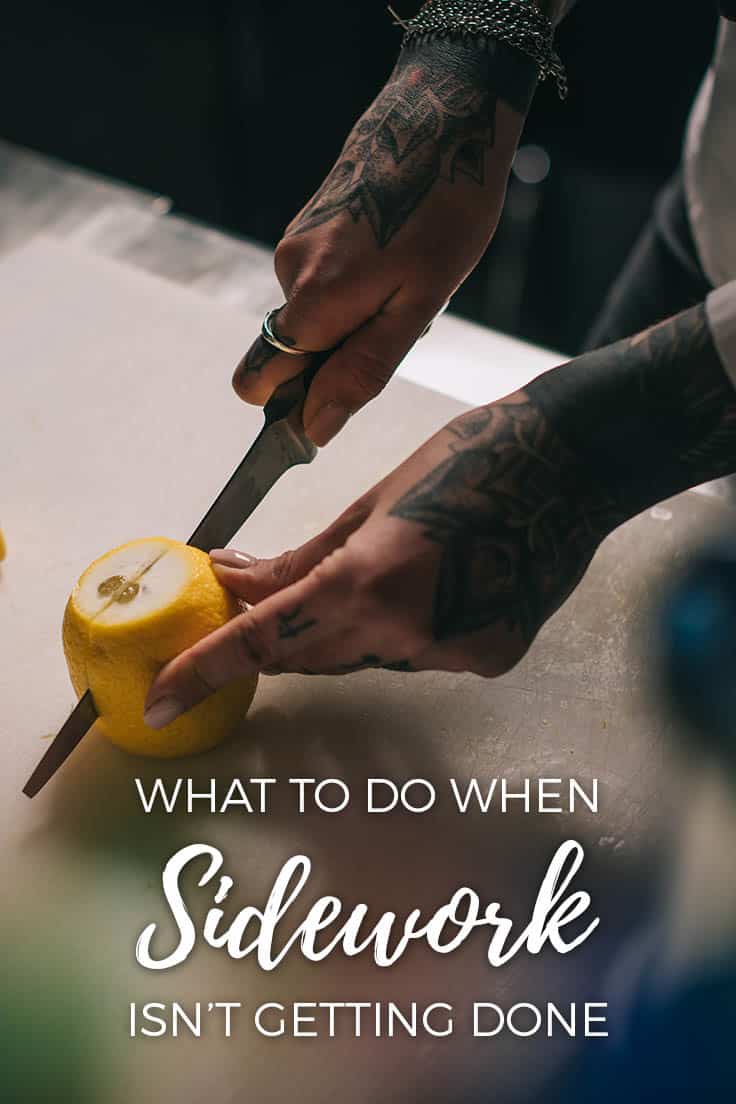
Whether it’s the beginning of the shift, the middle of the shift or the end of the night, there is always sidework that needs to be done. Sometimes some of these items can fall through the cracks and become frustrating for everyone involved.How do you make sure that everything gets done without your staff going Lord of the Flies blaming each other?
Check lists. That’s right grab that clipboard and make sure everything gets done!
We’ve all been there before: it’s a busy Friday night and you’ve just walked in the door for your shift to find none of the prep work is done. You spend the rest of the night is playing catch up. Another common scenario: you walk in and start setting up the bar or restaurant for the opening shift and there’s a pile of dishes that need to be done, no one wiped down the bar top, and the bar hasn’t been restocked. I’m getting anxious just thinking about it!
Starting with Communication
Before you start planning your coworkers’ demise (or their funeral), take a step back and try to find a solution, (especially if this is a common occurrence.) Most of the time these scenarios can be the result of poor communication – for example, no one has told the appropriate people what needs to occur to properly open/close the bar.
The first thing to consider is whether or not there is a clear outline of what needs to happen, and whether the appropriate people have been informed and trained accordingly.
Sidework Checklists
You can start by simply asking the manager if opening / closing / running side work checklists exist, and if not, request that they be created. Hopefully this is enough to have the manager start the process. If the manager says they are too busy or makes a promise and doesn’t follow through, it may be time to ask if you can volunteer to work with the other staff members to put one together.
Whether it’s a manager or not, whoever is creating these checklists should be sure to consult the whole team throughout the process. By working with a few different people (as many as possible) you’ll get the benefit of many different viewpoints and an opportunity for everyone to see just how much side work there is to be done. Plus, everyone will be much more willing to implement the checklists if they feel like they had a hand in their creation. Hopefully this process will go quickly and there will be little to no pushback… hopefully.
Responsibility & Accountability
Creating the list is great, but if nothing improves as a result of this process, it’s a waste of time for everyone. Even worse, it can be demoralizing for the staff that got their hopes up but fail to see improvement, potentially resulting in people becoming disenchanted and eventually leaving.
The last thing you want to do is create an environment where your best employees (i.e. the ones excited about the checklists) leave and you are left with the folks who hate side work! Following up and holding people accountable is critical to making the change.
Ideally the employees would self monitor to make sure that everything gets done. This goes along way to establishing a strong culture and keeps the manager from having to babysit every shift and checklist.
Here’s how I divided up side work responsibilities on our team:
First, divide the pool of opening side work responsibilities into logical lists. Our team had three bartenders, so this is roughly how we did it:
- Bartender 1 (or opening bartender) has the following responsibilities:
- Heavy opening duties (cutting garnishes, filling up straws, coaster, napkins, printer paper, etc, fresh salt and sugar stations, icing all the wells creating stock list for barbacks, replenishing silverware)
- Equal amount of running side work (replenish plates, napkins, etc.)
- Light closing duties (burning their ice, wiping down their speed rack, 25 roll ups, etc)
- Bartender 2 (or the mid bartender) has the following responsibilities:
- Medium opening duties (setting up their garnish station, etc.)
- Equal amount of running side work (replenish silverware, coasters wine glasses)
- Medium closing duties (closing down their well, wiping down their bottles, 25 roll ups, creating a bar back stock list, etc.)
- Bartender 3 (Closing bartender) has the following responsibilities:
- Light opening duties (make sure their station is set up)
- Light running side work
- Heavy closing duties (final wipe down of bar, clean all remaining bar mats, pour hot water down beer lines, etc)
Each bartender also verifies that the previous person’s checklist has been completed:
- Bartender 2 makes sure that Bartenders 1 has completed the opening side work, if not bartender 2 helps to get bartender 1 up to speed
- Bartender 3 does the same thing for bartender 2, etc.
If you are utilizing barbacks, you can change the process to make sure they are included.
- Bartender 1 verifies that barback 1 has finished their opening responsibilities
Bartender 2 verifies that bartender 1 has finished their responsibilities
etc
For closing side work, each bartender can check out with the closing manager who makes sure their cash drawer is accurate and all side work is done. If the person closing the bar is actually the closing bartender, then have the bartender leave the closing checklist in the empty cash drawer to be verified by the opening manager or opening bartender.
I mentioned it earlier but I’ll say it again – the real beauty of this system is that it is not the manager who is babysitting the team to make sure everyone does their work. Rather, it is your peer – namely, the next bartender on shift. In addition, if the work isn’t done, the next bartender assists until it is complete. (And the earlier bartender ideally doesn’t leave until it is.) This format strengthens the camaraderie of the staff and helps create the “we’re in this together” mindset that makes great teams thrive.
A few tips:
Here are some extra tips for things that often get overlooked when implementing side work checklists.
- Decide who is going to replenish the missing stock. Is it at the end of the night or the beginning of the next shift? I’m always a fan of restocking at the end of the night, since a larger stock list also means that the bartender made more money, so they hopefully won’t mind as much!
- Check back in with everyone two weeks after the roll out to make sure the lists are fair and balanced. Hint: they probably aren’t. If you don’t find anything to fix after two weeks, you didn’t ask enough people. There’s always something to improve and your team will appreciate the effort you put into continuing to improve the process.
- Consider including photos at what a properly set up bar looks like including placements of bottles, garnishes, napkins, etc. Some people are more visually oriented and this makes training a new bartender much easier. Take photos of a properly closed down bar as well.
- The first few weeks will take an active commitment to ensure that everything is getting done, but this is also the most important time. As a manager (or the staff member spearheading the effort), devote the time and energy to make sure this is properly implemented. If things go well in beginning, the changes are far more likely to ‘stick.’
- Make sure the lists are mounted somewhere that is easily accessible. Consider printing out each person’s responsibilities and stapling it to their cash drawer check out sheets or laminating each sheet and taping them inside a cabinet, inside the beer fridge or in the bottom of the cash drawer. If you only put it in the “bar binder” then you may find that your team loses traction quickly, because they “forgot.” Remove as many barriers as possible to ensure this new process gets off to a good start!
If you’re showing up for your shift and finding that the side work is consistently not done, chances are pretty good you’re not the only one frustrated. Take initiative to fix the problem – it’s a great opportunity for you to help establish yourself as an engaged and driven member of the bar staff, and it’s fantastic management experience for your resume as well. But most importantly, getting the problem fixed will make your life easier and help you enjoy your shift instead of spending it playing catch up!




